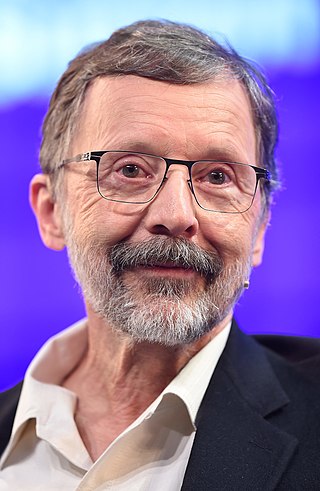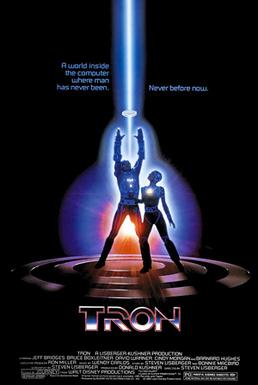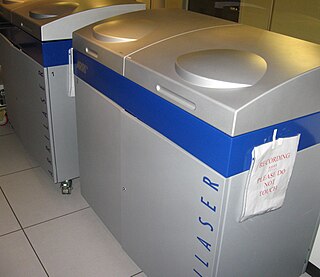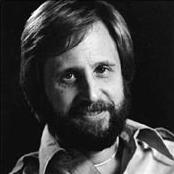
Computer animation is the process used for digitally generating animations. The more general term computer-generated imagery (CGI) encompasses both static scenes and dynamic images, while computer animation only refers to moving images. Modern computer animation usually uses 3D computer graphics to generate a three-dimensional picture. The target of the animation is sometimes the computer itself, while other times it is film.
Foonly Inc. was an American computer company formed by Dave Poole in 1976, that produced a series of DEC PDP-10 compatible mainframe computers, named Foonly F1 to Foonly F5.
Symbolics, Inc., was a privately held American computer manufacturer that acquired the assets of the former company and continues to sell and maintain the Open Genera Lisp system and the Macsyma computer algebra system.

Edwin Earl "Ed" Catmull is an American computer scientist who is the co-founder of Pixar and was the President of Walt Disney Animation Studios. He has been honored for his contributions to 3D computer graphics, including the 2019 ACM Turing Award.

Tron is a 1982 American science fiction action-adventure film written and directed by Steven Lisberger from a story by Lisberger and Bonnie MacBird. The film stars Jeff Bridges as Kevin Flynn, a computer programmer and video game developer who is transported inside the software world of a mainframe computer where he interacts with programs in his attempt to escape; it also stars Bruce Boxleitner, David Warner, Cindy Morgan, and Barnard Hughes. Tron, along with The Last Starfighter, has the distinction of being one of cinema's earliest films to use extensive computer-generated imagery (CGI).

Edward Fredkin is a distinguished career professor at Carnegie Mellon University (CMU), and an early pioneer of digital physics.

A film recorder is a graphical output device for transferring images to photographic film from a digital source. In a typical film recorder, an image is passed from a host computer to a mechanism to expose film through a variety of methods, historically by direct photography of a high-resolution cathode ray tube (CRT) display. The exposed film can then be developed using conventional developing techniques, and displayed with a slide or motion picture projector. The use of film recorders predates the current use of digital projectors, which eliminate the time and cost involved in the intermediate step of transferring computer images to film stock, instead directly displaying the image signal from a computer. Motion picture film scanners are the opposite of film recorders, copying content from film stock to a computer system. Film recorders can be thought of as modern versions of Kinescopes.
VirtualMagic Animation, Inc. was an American traditional animation studio and software development company based out of Los Angeles, California. The studio produced animation for television series and commercials, and provided ink and paint services to animated TV series such as The Ren and Stimpy Show and The Simpsons and films such as We're Back! A Dinosaur's Story. Its software division was best known for developing USAnimation, a high-end software package designed to facilitate the traditional animation process using digital technologies.
Mathematical Applications Group, Inc. was an early computer technology company founded in 1966 by Dr. Philip Mittelman and located in Elmsford, New York, where it was evaluating nuclear radiation exposure. By modeling structures using combinatorial geometry mathematics and applying monte carlo radiation ray tracing techniques, the mathematicians could estimate exposures at various distances and relative locations in and around fictional structures. In 1972, the graphics group called MAGi/SynthaVision was formed at MAGi by Robert Goldstein.
Digital puppetry is the manipulation and performance of digitally animated 2D or 3D figures and objects in a virtual environment that are rendered in real time by computers. It is most commonly used in filmmaking and television production, but has also been used in interactive theme park attractions and live theatre.
Wavefront Technologies was a computer graphics company that developed and sold animation software used in Hollywood motion pictures and other industries. It was founded in 1984, in Santa Barbara, California, by Bill Kovacs, Larry Barels, Mark Sylvester. They started the company to produce computer graphics for movies and television commercials, and to market their own software, as there were no off-the-shelf computer animation tools available at the time. In 1995, Wavefront Technologies was acquired by Silicon Graphics, and merged with Alias Research to form Alias|Wavefront.

Motion graphics are pieces of animation or digital footage which create the illusion of motion or rotation, and are usually combined with audio for use in multimedia projects. Motion graphics are usually displayed via electronic media technology, but may also be displayed via manual powered technology. The term distinguishes static graphics from those with a transforming appearance over time, without over-specifying the form. While any form of experimental or abstract animation can be called motion graphics, the term typically more explicitly refers to the commercial application of animation and effects to video, film, TV, and interactive applications.
Robert Abel and Associates (RA&A) was an American pioneering production company specializing in television commercials made with computer graphics. Robert Abel's company, RA&A was especially known for their art direction and won many Clio Awards.

Robert Abel was an American pioneer in visual effects, computer animation and interactive media, best known for the work of his company, Robert Abel and Associates.

Digital Effects Inc. was an early and innovative computer animation studio at 321 West 44th street in New York City. It was the first computer graphics house in New York City when it opened in 1978, and operated until 1986. It was founded by Judson Rosebush, Jeff Kleiser, Don Leich, David Cox, Bob Hoffman, Jan Prins, and others. Many of the original group came from Syracuse University, where Rosebush taught computer graphics. Rosebush developed the animation software APL Visions and FORTRAN Visions. Kleiser later went on to found Kleiser-Walczak Construction Company, which experimented with creating synthespians and made the animation for Monsters of Grace.

Digital Productions was a computer animation company in Los Angeles, California, that produced advertisements and special effects for films in the 1980s.
Judson Rosebush is a director and producer of multimedia products and computer animation, an author, artist and media theorist. He is the founder of Digital Effects Inc. and the Judson Rosebush Company. He is the former editor of Pixel Vision magazine, the serialized Pixel Handbook, and a columnist for CD-ROM Professional magazine. He has worked in radio and TV, film and video, sound, print, and hypermedia, including CD-ROM and the Internet. He has been an ACM National Lecturer since the late 1980s and is a recipient of its Distinguished Speaker Award.
Gregory Peter Panos is an American writer, futurist, educator, strategic planning consultant, conference / event producer, and technology evangelist in augmented reality, virtual reality, human simulation, motion capture, performance animation, 3D character animation, human-computer interaction, and user experience design.

Computer graphics deals with generating images and art with the aid of computers. Today, computer graphics is a core technology in digital photography, film, video games, digital art, cell phone and computer displays, and many specialized applications. A great deal of specialized hardware and software has been developed, with the displays of most devices being driven by computer graphics hardware. It is a vast and recently developed area of computer science. The phrase was coined in 1960 by computer graphics researchers Verne Hudson and William Fetter of Boeing. It is often abbreviated as CG, or typically in the context of film as computer generated imagery (CGI). The non-artistic aspects of computer graphics are the subject of computer science research.
The history of computer animation began as early as the 1940s and 1950s, when people began to experiment with computer graphics – most notably by John Whitney. It was only by the early 1960s when digital computers had become widely established, that new avenues for innovative computer graphics blossomed. Initially, uses were mainly for scientific, engineering and other research purposes, but artistic experimentation began to make its appearance by the mid-1960s – most notably by Dr Thomas Calvert. By the mid-1970s, many such efforts were beginning to enter into public media. Much computer graphics at this time involved 2-dimensional imagery, though increasingly as computer power improved, efforts to achieve 3-dimensional realism became the emphasis. By the late 1980s, photo-realistic 3D was beginning to appear in film movies, and by mid-1990s had developed to the point where 3D animation could be used for entire feature film production.










